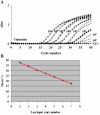Viral regulatory region effects on vertical transmission of polyomavirus SV40 in hamsters
- PMID: 19181358
- PMCID: PMC2668977
- DOI: 10.1016/j.virol.2008.12.040
Viral regulatory region effects on vertical transmission of polyomavirus SV40 in hamsters
Abstract
Viral strain differences influence the oncogenic potential of polyomavirus simian virus 40 (SV40). We hypothesized that viral strain differences might also affect vertical transmission of SV40 in susceptible hosts. Pregnant Syrian golden hamsters were inoculated intraperitoneally with 10(7) plaque-forming units of SV40 and offspring were sacrificed post-delivery (1-21 days, 6 months). Organ extracts were analyzed for SV40 DNA by polymerase chain reaction assay. Transmission of SV40 from mother to offspring was detected in over half of litters. Most placentas were virus-positive. Mothers inoculated with SV40 strains containing complex regulatory regions transmitted virus more frequently than those infected with simple enhancer viruses (p<0.001). Virus was detected more often in progeny brain than in spleen (p<0.05). Several progeny were virus-positive at 6 months of age, suggesting viral persistence. Maternal animals retained virus in several tissues through day 21 and developed T-antigen antibodies. These results indicate that SV40 replicates in hamsters, vertical transmission of SV40 can occur, and the viral regulatory region influences transmission.
Figures


References
-
- Andrews CA, Daniel RW, Shah KV. Serologic studies of papovavirus infections in pregnant women and renal transplant recipients. Prog. Clin. Biol. Res. 1983;105:133–141. - PubMed
-
- Arrington AS, Moore MS, Butel JS. SV40-positive brain tumor in scientist with risk of laboratory exposure to the virus. Oncogene. 2004;23:2231–2235. - PubMed
-
- Bergsagel DJ, Finegold MJ, Butel JS, Kupsky WJ, Garcea RL. DNA sequences similar to those of simian virus 40 in ependymomas and choroid plexus tumors of childhood. N. Engl. J. Med. 1992;326:988–993. - PubMed
-
- Black PH, Rowe WP. Viral studies of SV40 tumorigenesis in hamsters. J. Natl. Cancer Inst. 1964;32:253–265. - PubMed
Publication types
MeSH terms
Substances
Grants and funding
LinkOut - more resources
Full Text Sources

